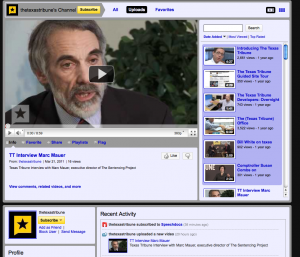Part 2
YouTube for journalists
Finished video pieces should be uploaded to YouTube and then embedded on your website or fed to your site through an RSS feed. Hosting the videos on YouTube takes advantage of YouTube’s huge community, meaning more people can stumble upon the work, saving space and bandwidth on individual websites.
Journalists should also post additional raw video and special extra content on YouTube.

The Texas Tribune has an active YouTube channel that features newsmaker interviews and behind-the-scenes video.
They can create playlists for “Behind the Scenes” content or separate video playlists for specific beats.
YouTube also has a useful, if under-utilized, feature that allows owners to layer text, clickable hotspots and links over videos. The Annotations Editor helps video owners guide viewers to other content, provide contextual information and invite engagement in the comment field and through video responses.
YouTube Direct is an easy way for media organizations to collect and manage user-submitted content. The service allows viewers to upload video onto YouTube via an organization’s website. Encourage viewers to submit their own responses to videos, contests or citizen journalism pieces. These can then be used as content for a news site and curated into a playlist for easy viewing and promotion.
If you plan to crowdsource for news on your YouTube account, another useful tool is YouTube Moderator. The service allows users to curate commentary, questions and ideas on a channel. This information can then be used for story planning and follow-up interviews.
CitizenTube is a YouTube blog that highlights the pulse of YouTube users. The service curates the latest and most relevant news videos submitted from citizen journalists from around the world. The video channel also serves as a breaking-news outlet during crisis situations, like in the 2011 Egyptian and Tunisian protests.
Reporters and editors can get a view of local issues with in the News Near You section of the site. The service geo-locates users based on address and displays relevant content within 100 miles that has been produced by pre-selected news partners and citizen journalists.
YouTube also offers a Reporter’s Center, which may be useful for community contributors. A portion of the site offers instructional videos on basic reporting techniques and insight on how to deal with touchy subjects like privacy and fact checking. It should supplement your site’s reporting policies.
Tips for journalists to get the most out of YouTube
Tip 1: Name each video.
Name it to reflect your news site and/or niche. Include in your video title the name of your company and a keyword or two. It will help with search results and help give context to new viewers who stumble upon the video. Most video capture programs will simply call your file something like, “Capture_003_GYH,” in some sequential method. But it would be much easier to find a video named “Oakland Local: Spring Hop Hop OMCA.”
Tip 2: Customize your channel.
Before you start publishing videos, make sure you upload a logo, change the background, and link to other sites.
Tip 3: Create a transcript for your video as you post it.
If it’s an “important” video, consider publishing a transcript. YouTube has capabilities (in beta as of Feb 2011) that allow you to upload your video’s dialogue as a text file or a Word doc. YouTube will process the file using a speech-to-text algorithm and run it alongside your video at no cost. This is effective for optimizing user experience, accessibility, and your video’s recognition in search engine queries.
Tip 4: Add captions so your video is accessible to all.
Auto-captioning has been available to all YouTube users since March 2010 and uses the same voice recognition we recommended in Tip 2.
Tip 5: Police the trolls in the comments section.
Monitor your comment section diligently. It is important to regularly monitor comment conversations to maintain a civil and welcoming tone, as well as to avoid interlopers or spammers. If you need to, moderate comments before they go live. But more optimal is regular visiting and replying to comments.
Tip 6: Be present in discussions and serve as a curator.
Have someone put effort into being present on your YouTube channel. Subscribe and “favorite” other channels and videos, make friends with others in your community of interest, and share videos through other social media.
Tip 7: Don’t forget to tag your video.
Tags are the easiest way for others to discover items of interest on YouTube. Without tags, your videos are destined for obscurity. Even more important, be generous with tags. For example, using ” Oakland”, “Oakland, CA”, and “Oaktown” are appropriate if your video is focused on that area, as that is how users will search for videos of interest. Monitor via YouTube Insights how your tags perform and use the best ones more in the future.
Tip 8: Promote your videos everywhere!
Facebook, Twitter and your own website are all essential places to promote your video. You can create an automated upload from YouTube to your Facebook page via YouTube settings; you can also easily embed your video in a blog post or news story using pre-coded HTML. Don’t hesitate to share and embed videos. This is one of the most popular activities on the web, across all social media and will get you significantly more traffic than just posting video and waiting for it to be found.
